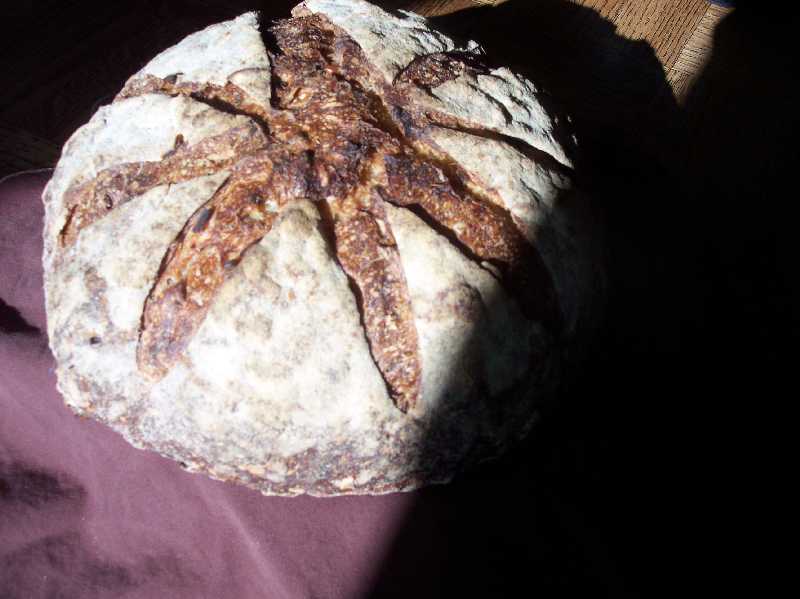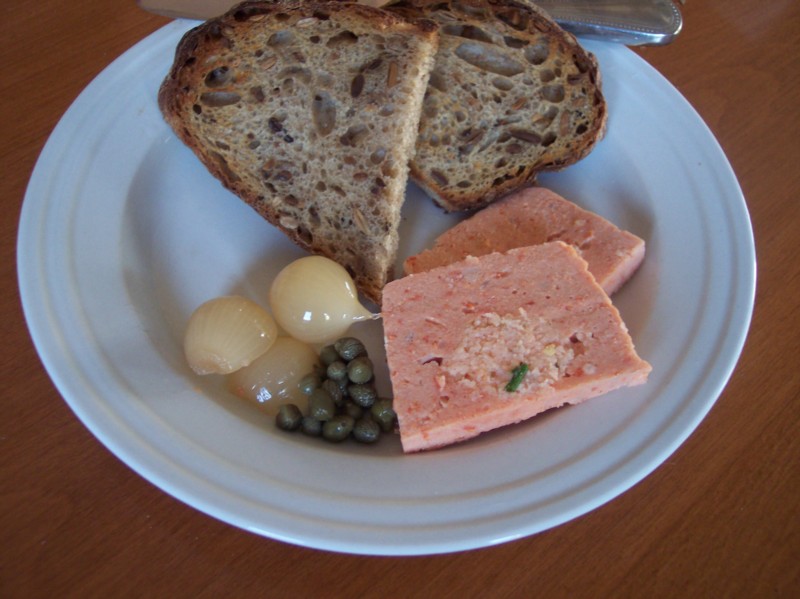This was going to be a blow-by-blow account of reviving a starter that had been dried for travel. Yeah, my eyes are starting to glaze already, too. So this will get more of a Readers Digest treatment. And I'll try to stay awake until the end. What you do is up to you.
Here's the back story: Man lives in Pretoria, South Africa. Man has sourdough starter. Man will repatriate to his home in Kansas City. Man does not wish to lose his starter or begin a new one after his return.
Still with me? Good.
Having read two different methods right here on TFL for preparing a starter for travel, I chose to do (drumroll, please) both! And knowing that some or all of my luggage would be subjected to the tender mercies of either the TSA or U.S. Customs, I wanted to make sure that I had enough with me that at least one packet got through. Or so I hoped.
Technique #1 involves adding enough flour (if your starter is runny) or enough water (if your starter is more like a dough) to some of said starter to achieve a thick batter consistency that is still smearable. I don't know if smearable is a word but it is the key. The traveler (your faithful reporter in this instance) needs to smear a thin layer of the suitably hydrated starter on a sheet of parchment paper and wait a day or two for the smear to dry to until it is roughly as crisp as potato chips. Or potato crisps, for those of you who are still in South Africa. The dried smears / chips / crisps can be broken into smaller pieces and placed in plastic bags for eventual placement in your baggage or on your person. Note that thinner smears = shorter drying times.
Technique #2 involves adding flour to your starter until it is so dry that it is reduced to crumbs. Some mechanical intervention will be necessary; perhaps the edge of a spoon or maybe a pastry blender or even a food processor. I can say that a mezzalune is effective. The more flour you try to force into the dough, the less cooperative it becomes; hence the need for mechanical assistance to cut it into ever smaller bits while force-feeding it yet more flour. As with the flakes, the crumbs can be bagged for travel.
I strongly recommend that you clearly label each bag so that there is no leeway for interpretation by the various uniformed officials who may have their hands in your luggage at some point. We all know what happens when we assume, right?
Thus prepared, your faithful reporter placed a baggie of dried starter in every piece of luggage. And, for reasons yet unclear, every bag and every baggie made it all the way to the proper destination. On the same day.
Being somewhat surprised to find myself the proud possessor of a surfeit of dried starter, I did what any American male worth his salt would do: I set up a competition. Keeping one baggie in reserve as insurance, I combined 10g of flaked starter and 25g of water in one container and 10g of crumbed starter and 25g of water in another container. Here's how they looked at the start of the competition, flakes to the left and granules to the right:

Pretty exciting, huh? Other than some fogging of the inside of each jar, they looked about the same 24 hours later so I added 15g of flour of each. At the end of the second 24-hour period, they were still pretty flat. There was a whiff of...something...from the granules jar but the flakes jar smelled mostly of wet flour. By the end of Day 3, there was evidence of bubbles in the granules jar and a hint of expansion. The flakes jar was still pretty quiet; just a stray bubble or two.
Yep, that's right, the excitement continues to build!
At the end of Day 3, I discarded half of each sample and added water and flour in a 1:2:3 ratio. I also moved them to some smaller plastic containers. Here's how they looked after dinner and settling into their new digs:

Just to keep you on your toes, I've switched the granules container to the left and the flakes container to the right.
Some 12 hours later, there was some genuine growth going on:

And from a different perspective:

The crumbs sample has expanded noticeably and is riddled with bubbles. The flakes sample has expanded just slightly and has fewer bubbles.
And that's pretty much how it went for the next few days. The crumbs sample consistently out-performed the flakes sample. Even on a 12-hour feeding schedule, the crumbs sample smelled consistently of acetone which suggests that it was burning through its food between feedings. The flakes sample never developed a notable yeasty / fruity / sour odor in the week's time that I ran the comparison, although it did get past the wet flour odor.
If your eyes are still open at this point, you can hang on for the wrap-up.
For short-term storage, such as for travel, I would choose the granules approach to drying starter over the flaked approach. I've done the flakes technique twice now and it required a full week to get back to a sluggish level of activity in both cases. For longer storage, I'd use the flakes. Why? Because it seems to be a more stable form that is less susceptible environmental upsets.
I have some notions about the difference in behavior of the two. First, the granules weren't as dry as the flakes. That seems to have allowed the yeasts and bacteria of the starter to get back to work faster, possibly because they were less stressed and did not shut down entirely. Second, although the organisms were tightly bound in a relatively dry environment, they were also surrounded by food even if they could not exploit it easily. The down side for the granules is that their higher moisture content would make them more susceptible to attack by molds and other organisms, which militates against using them as a long-term storage option.
The good news is that there are options for the traveler, as well as for disaster recovery. The easiest way to travel with a starter, of course, is to tuck a small blob in a plastic bag or other container. That's probably the easiest way to lose it to a zealous inspector, too.
And the reward for any of you who have stayed awake through this entire dissertation? Pictures of the pain au levain baked with the reconstituted starter, which now smells the way a healthy and happy starter should. Note that the bread was made at about Day 7 or Day 8; not because of the starter's readiness but because of the baker's schedule. The starter could probably have been used on Day 4 or Day 5. First, the loaf:

And then the crumb:

Happy travels!
Paul






















